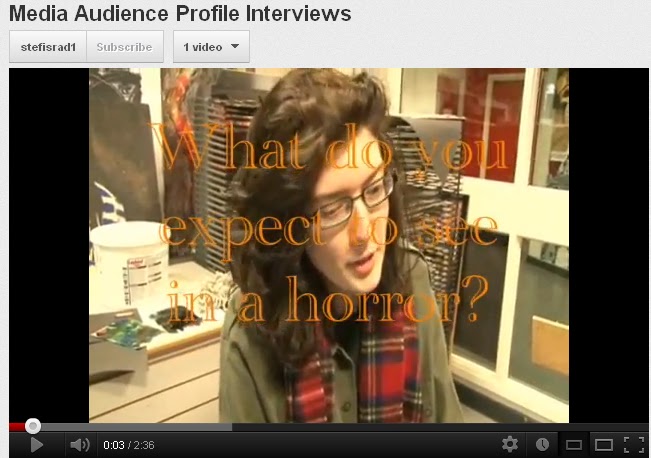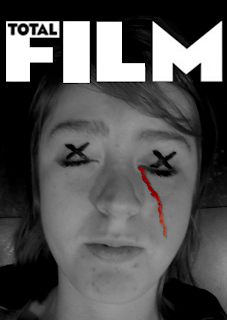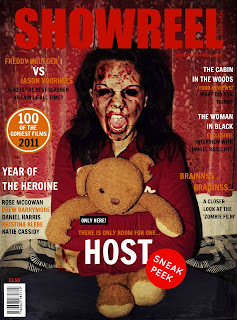Why would someone want to go and watch your film?Each element of the film is different in each way, well in comparison to existing psychological horror films. One reason being that it is set in an earlier era, where asylums were at their worst, unlike any horror film produced now days where it is all modern and more blood and gore than challenging the mind. I hope to create a trailer that doesn’t give too much of the storyline away, yet it draws the target audience in.
Who are the target audience and how will you attract them?The target audience we have chosen is 16-25 year olds, they will grab the concept of the film and won’t be confused like, say, a 12 year old would. It is known that younger people are more drawn to horror films than the older generation. By the audience seeing the elements we shall involve and leave out in the trailer should draw them in; we wish to involve small bits (from the notes we have taken from example trailers) which are perplexing enough for them to see it.
What is the USP of your film and why?Personally, I think the USP is the hint of different inspirations of each trailer we watched and analysed. Though this is an extremely strange USP to have I think that is what makes it so much more unique, it is clear that ‘Sanatorium’ pays homage to the influence of ‘The Ward’ such as the whole idea of it being in an asylum echoes the clinical theme of The Ward. However it does not mirror it in any way at all, as it also soaks in the idea of the photography set in the opening trailer of ‘Silent House’, elements such as the provided examples makes our trailer ever more so unique.
How will you have evidence of a variety of shot types, camera movement, editing and transitions?Well with the technology and software provided by the department we shall use the following equipment;
o Imovie 06 and Final Cut Express 4
o Audio software
o Camcorders- using digital video tapes
o Mac computers
o Photoshop
I shall also provide screen captions, daily blog posts on ‘Blogger’ where It enables us to provide rough cuts of our work, along with podcasts of our plan for the week or how we progressed that previous day. Putting together multiple videos of the variety of shots we shall be using, along with the gradual progression of our editing via Final Cut Express 4 and Imovie 06. All of this, as I said, shall be provided weekly.
How does the music you have created/will create match the genre?
The planned music is to be an eerie, jack in a box simple tune which will result in a fast paced climax ending. The reason being is that most psychological horrors are creepy and make the audience sceptical so by adding such a taunting and not particularly lively melody followed by a deep beat whilst things are gradually revealed then a blank silence, then the editing gradually picks up pace – end of trailer. But the main part of the effect is the innocent melody at the start, as it sets up a non expected ending as it is so effective. (Though this method is a lot more frequently used nowadays)
Will you change your conventions at all with your trailer?
The expected genre features are;
· Dark lighting
· Blood
· Thriller
· Idiocy
· Attractive teenagers
· Killers/villain
· Torture/death
· Tension
· Loud noises/screaming
· Fast pace editing
· Build up of tension
· Enhanced diagetic sound
The trailer contains only a few of these features;
- Blood
- Killers/villain
- Torture/death
- Loud noises (when fast paced editing)
- Build up of tension
- Diagetic sounds (panting, hospital sounds)
Seeing as these are expected, and play such a huge part in a psychological horror then we don’t need to alter them in any way.
- Blood
- Killers/villain
- Torture/death
- Loud noises (when fast paced editing)
- Build up of tension
- Diagetic sounds (panting, hospital sounds)
Seeing as these are expected, and play such a huge part in a psychological horror then we don’t need to alter them in any way.
How will the trailer fulfil audience expectations follow the conventions of a trailer?
As I already stated in the previous question, we shall be using multiple conventions;
- Blood
- Killers/villain
- Torture/death
- Loud noises (when fast paced editing)
- Build up of tension
- Diagetic sounds (panting, hospital sounds)
- Killers/villain
- Torture/death
- Loud noises (when fast paced editing)
- Build up of tension
- Diagetic sounds (panting, hospital sounds)
This is what ours is going to consist of, but instead of having the constant cuts and snappy editing from the start, it will only happen in the establishing shot and the fast paced editing at the end – resulting in a tension building trailer, meeting the audience expectations.
Does it follow Todorovs narrative?Todorov attempted to create a simple technique that applies to many stories’ structure. This was his theory, he said that there has to be a beginning to set up the events of the story, there then has to be an disruption to these events. There then has to be a resolution to restore the order and make a new equilibrium (beginning)
Do you have any of Propps characters narrative in the trailer Propps narrative is used in the trailer, though it only consists of 4 snippets of his narrative - it contains;
- Absentation - A member of a family leaves the security of the home environment. This may be the hero or some other member of the family
- Interdiction - An interdiction is addressed to the hero ('don't go there', 'don't do this')
- Violation of Interdiction - The interdiction is violated (villain enters the tale)
- Delivery - The villain gains information about the victim.











